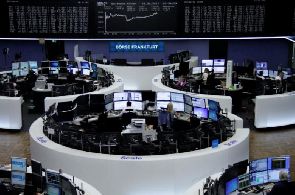European stock markets fell for a third straight day on Thursday, as battered oil prices hovered near seven-month lows hit overnight on worries about a supply glut and falling demand.
Britain’s FTSE 100 .FTSE, Germany’s DAX .GDAXI and France’s CAC 40 .FCHI all slipped 0.3-0.4 percent as trading in Europe got under way. U.S. stock futures were also a touch weaker ESc1 1YMc1.
Sharp falls in oil prices this week have hurt energy stocks and dampened investors’ expectations for higher inflation that would pave the way for tighter monetary policies among major central banks.
“As far as the market mentality is concerned, as long as the oil price keeps weakening, this is going to tell us something about the underlying capacity of the global economy to generate inflation on a sustained basis,” said Chris Scicluna, head of economic research at Daiwa Capital Markets.
In Asia, MSCI’s broadest index of Asia-Pacific shares outside Japan .MIAPJ0000PUS climbed 0.6 percent. But Japan’s Nikkei .N225 ended a touch lower as a stronger yen and a plunge in the shares of auto air bag-maker Takata Corp took a toll on sentiment.
Excitement after MSCI included mainland Chinese shares in its emerging market indexes this week further boosted China’s stock market, driving the blue-chip CSI300 index .CSI300 to the highest level in 1-1/2 years.
Oil prices were subdued as investors’ doubts that OPEC-led output cuts would dent a three-year glut offset data showing a drop in U.S. inventories.
“The time for contrarian trades in oil is fast approaching, but I would want to see some stability in price and the technicals start to become more convincing,” said Chris Weston, chief market strategist at IG in Melbourne.
U.S. crude futures CLc1 were a touch weaker at $42.50 a barrel. They closed down 1.6 percent on Wednesday after touching their lowest level since August.
Global benchmark Brent LCOc1 was also a tad softer at around $44.78 and within striking distance of seven-month lows hit on Wednesday. [O/R]
Since peaking in late February, crude has dropped around 20 percent, with only brief rallies, completely erasing gains at the end of the year in the wake of the initial OPEC-led production cut.
Subdued inflation and concerns about the outlook for world growth at a time when the U.S. Federal Reserve is raising interest rates have triggered a flattening in bond yield curves.
The gap between yields on U.S. five-year notes and 30-year bonds US5US30=TWEB flattened to 95 basis points, holding near its narrowest since December 2007.
A flattening yield curve is often viewed as a negative economic indicator as it shows concerns about the future pace of growth and inflation, because buyers of long-dated debt would demand higher yields if they expected higher costs.
In currency markets, the New Zealand dollar NZD= gained 0.5 percent to $0.7257 after the central bank held official cash rates at record lows but sounded less dovish than bears in the market had wagered on.
The U.S. dollar eased, falling 0.3 percent to 111.02 yen JPY=D4.
The dollar index .DXY, which measures the greenback against a basket of six major currencies, was roughly flat at 97.54, having retreated from a one-month high of 97.871 set on Tuesday.
The euro EUR=EBS was also flat at $1.1167, after Wednesday’s 0.3 percent gain.
The weaker dollar lifted spot gold XAU= 0.6 percent to $1,253.20 an ounce.








